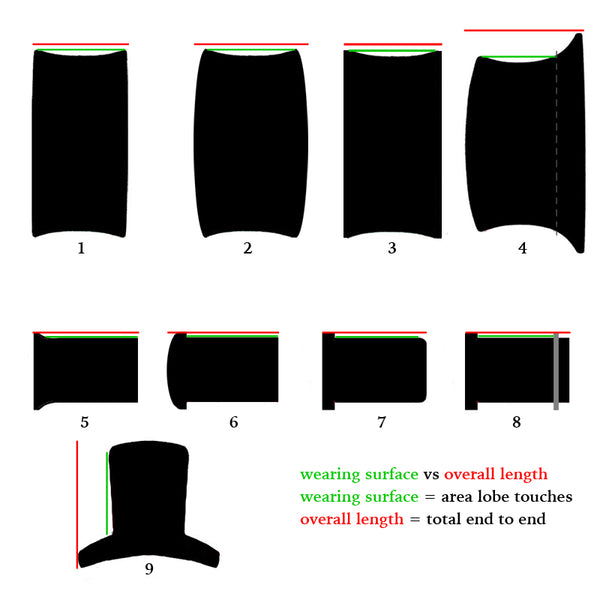Wearing Length vs Overall Length: Getting the Right Fit
It's important to know that the wearing length of jewelry is measured differently depending on the style of jewelry, and that it is not the same as "overall length," which varies wildly by style and only contributes to good fit in certain circumstances.
Wearing length is the area of the jewelry that fits inside your piercing. This measurement is relevant to good fit in all styles of jewelry.
Overall length is the total measurement of the jewelry from face to face, including any additional flare or face area. This measurement is only necessary in certain circumstances where length of the jewelry effects wear-ability in relation to other parts of the body other than the piercing itself. For example, the overall length is important for a conch or upper cartilage piercing where additional length may press on the area of the head behind the ear, and apply pressure to the piercing.
Diagram of jewelry styles with wearing length marked in green and overall length marked in red.

1. A flat faced double flared plug. Wearing length is measured from the inside of the flare edges. Overall length is measured from face to face.
2. A convex faced double flared plug. Wearing length is measured from the inside of the flare edges. Overal length is measured from face to face.
3. A flat faced double flared plug with flat flares. Wearing length is measured from inside the flare edges (the piercing cannot rest on the flat flare areas). Overall length is measured face to face.
4. A trumpet flared style plug. The dotted line denotes where the wearing surface ends on the front, because the larger portion of the slope cannot fit inside the piercing. Wearing surface is measured from inside the rear flare edge to the area on the front flare with the same diameter measurement. Overall length is measured from face to face.
5. A sloped single flared plug. Wearing length is measured from where the slope of the flare ends to the end of the plug. Overall length is measured from face to face.
6. A top-hat style single flare with a convex face. Wearing length is measured from the inside flare corner to the end of the plug. Overall length is measured from face to face.
7. A top-hat style single flare with a curved rear. Wearing length is measured from the inside flare corner to the beginning of the curve (the piercing cannot rest on the slope). Overall length is measured from face to face.
8. A top-hat style single flare with an o-ring groove for an o-ring. Wearing length is measured from the inside flare corner to the groove (the piercing cannot rest on the groove). Overall length is measured from face to face.
9. A labret (round or oval) with a standard concave t-back. Wearing length is measured from where the wearing shaft meets the wing to the end of the flat portion (the piercing cannot rest on the slope).
As you can see, in all cases, the overall length is always longer than the wearing surface because it includes other sections of the jewelry that do not rest inside the piercing. If you are custom ordering a piece of jewerly and you specify an overall length instead of a wearing length, your jewelry will not fit properly. Knowing your ideal wearing length, which can change as you stretch your piercings, ensures you're able to order jewelry that will fit well every time.
I welcome your feedback, and feel free to ask questions! Happy stretching!
Jared Karnes



